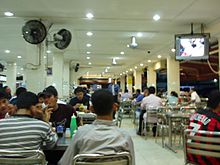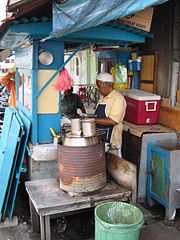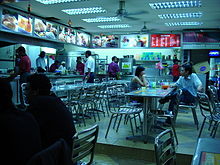- Mamak stall
-
A mamak stall, is a food establishment which serves mamak food. In Malaysia, the term mamak refers to Tamil Muslims, who generally own and operate them. Although traditionally operated from roadside stalls, some modern mamak stall operators have expanded their businesses into restaurant or cafe-type establishments. Mamak stalls tend to be popular among Malaysian youths as hang out spots, due to cheap food and beverages being served 24 hours a day, 365 days a year.
People of all races, religions and ages frequent mamak stalls to gossip or catch a late-night football game while enjoying a cup of hot teh tarik. No other eatery has quite as much cultural significance in Malaysia, save for the kopi tiam.
Contents
History
Certain Mamak stalls, such as this example in Kuala Lumpur, may remain open 24 hours a day.
The Malaysian Mamak (commonly known as Mamak) are Tamil Muslims of Malaysian nationality, whose forefathers mostly migrated from South India to the Malay Peninsula and various locations in Southeast Asia centuries ago. They are regarded as part of the Malaysian Indian community. Indian Muslims were believed to first arrive at Samudera (now Aceh in Sumatra, Indonesia) back in the early 10th century, and later settled down in Peninsular Malaysia. Although the origins of the word are perfectly benign, it is often used as a derogatory term for the Indian Muslim community in Malaysia.
The word 'Mamak' is from the Tamil term for maternal uncle, or 'maa-ma'. In the context of Singapore and Malaysia, children of all ethnic groups are taught to refer to adult neighbours, shopkeepers and even strangers as 'uncle' and 'auntie', as a form of respect for and deference towards elders. This term is used even though the adult may not be a member of the child's family, clan or even ethnic group/'race'. The origin of the term 'mamak stall' is likely from the practice of children addressing the shopkeeper as 'uncle', or 'mamak', in his native Tamil language, as a form of respect when interacting with him, and patronising his shop.
Mamak stalls and Hindu stalls are alike except the Mamaks, who are Muslims, do not serve pork but serves beef, whereas the Hindus do not serve beef and pork. There are also similar stalls run by local Malays, which are not to be confused with the Mamak.
Popularity of mamak stalls
 Malaysian Mamak restaurants may also include hanging televisions and misting fan systems.
Malaysian Mamak restaurants may also include hanging televisions and misting fan systems.
Newer mamak stalls have more of a cafe aspect, being well lit and furnished with stainless steel tables. Some are outfitted with large flat screen televisions, or even projectors, so that patrons can catch the latest programs or live matches as they dine. Some mamak stalls also provide free wi-fi service. Interestingly, most modern mamak stalls attempt to retain the charm of open air dining of its predecessors by setting up tables on a patio, the shoplot's walkway or even on the street. Nevertheless, all mamak stalls provide a casual ambiance and affordable food to locals who need a place to unwind or socialise.
Criticism
The staff in mamak stalls often have very long working hours and poor working conditions. Many stalls are open 24 hours a day, 7 days a week, closing only for noon prayers on Fridays and during each year's two Eid holidays. The long opening hours make cleaning more difficult, so hygiene can be poor.
Mamak restaurant food tends to be unhealthy with high levels of fat and sugar. Teh tarik is strong tea with large doses of sweetened creamer (synthetic milk made from palm oil) and evaporated milk. There are also several ways to prepare or embellish the basic roti canai, some of which involve large amounts of margarine (roti planta), sugar (roti tissue), or both (roti bom).
Mamak stalls originated as roadside dining and this tradition continues despite the restaurants becoming bigger and more spacious. Dining areas commonly extend onto five foot pathways and busy intersections. This practice is illegal and hazardous to customers as well as road users. There have been cases of mamak stall patrons being killed in road traffic accidents while dining at the road side[citation needed]. Despite local authority efforts to remove illegal roadside dining, many restaurant operators continue to extend their dining areas onto walkways, roads and car parks.
Mamak fare
A mamak stall usually offers different varieties of roti canai to eat and teh tarik or Milo to drink. Most mamak stalls also serve several varieties of rice, such as nasi lemak and nasi goreng, as well as noodle dishes such as mee goreng (fried noodles). Some stalls also offer satay and Western dishes.
A typical Mamak stall will offer the following dishes, though this differs from stall to stall:
- Roti Canai
- Roti Telur
- Teh Tarik (literally 'Pulled Tea')
- Half-Boiled Eggs
- Goat Milk
- Murtabak
- Thosai
- Chapati
- Nasi Kandar
- Nasi Briyani
- Nasi Lemak
- Maggi Goreng
- Mee Goreng (Fried noodles)
- IndoMie Mi Goreng
- Pasembur
- Mamak Rojak
- Sup Kambing (Goat soup)
- Sup Ayam (Chicken Soup)
- Sup Tulang
- Roti Tissue
- Roti Bakar
- Roti Boom
- Roti Naan & Tandoori Chicken
- Poori
Malay Tomyam stall
Recently, in order to attract more customers, some Mamak restaurants have added an extra stall in their restaurant. The stall, which is operated individually by either an ethnic Malay from the North East Peninsular Malaysia or an ethnic Malay from Southern Thailand, is known as Malay Tom yam stall. Customers therefore have more choice, such as:
- Tom Yam
- Nasi paprik
- Nasi Goreng Kampung (Village fried rice)
- Nasi Goreng Cina (Chinese fried rice)
- Nasi Goreng USA (USA fried rice)
- Nasi Masak Merah (Cooked red rice)
- Nasi Pattaya
- Telur Bistik
- Sayur Campur ('Mixed' vegetables)
- Ikan Pedas (Spicy fish)
- Nasi LaLa (LaLa rice)
Tom Yam stalls can also be found by the street or at designated areas such as car parks at night. The nocturnal operating hours help to disguise the generally filthy state of some of the stalls. Surprisingly, these stalls tend to be popular. Many tom yam stalls are built illegally, usually on land reserved for public roads. Attempts to remove these illegal stalls have been fairly successful[citation needed] but such attempts can have a political price. One local politician who was a town councilor was put to shame when illegal traders whose stalls were demolished made known to the public that the politician's son himself was running a nearby stall built illegally on public road reserve land. His stall had been spared while others were demolished.[citation needed]
The tomyam stalls first appeared in Peninsular Malaysia circa late 1970s and early 1980s. Unlike local Malay food, the food is basically Thai based and somewhat similar to the cuisine in the state of Kelantan. The Tom Yam dishes have a mix of typically sweet, hot and sour flavours. Basically the choice of dishes available at Tom Yam stalls are similar. As the dishes are cooked immediately and quickly when the customer wants it, Tom Yam stalls are the Malay equivalent of the fastfood outlets albeit the Thai based cuisine.
See also
External links
- Malaysian Food
- Ma2k ComciComca
- The 'Mamak Stall' Culture
- Mamak-ing, A Malaysian word for tourists to get acquainted to
Café · Cafe church · Café Philosophique · Cannabis coffee shop · Cat cafe · Cosplay restaurant (Maid cafe) · Internet café · Konditorei · Kopi tiam · Mamak stall · Manga cafe · Manhwabang · Meikyoku kissa · No-pan kissa · Parisian café · Penny University · Sidewalk cafe · Utagoe coffeehouse · Viennese Coffee HouseCategories:- Malaysian cuisine
- Restaurants in Malaysia
- Malaysian culture
- Types of coffeehouses
- Types of restaurants
Wikimedia Foundation. 2010.


